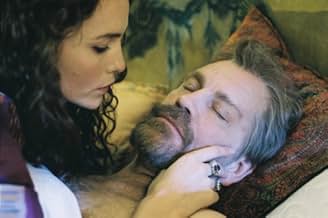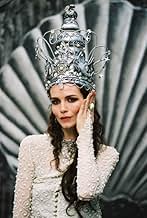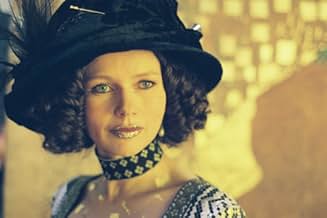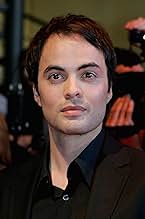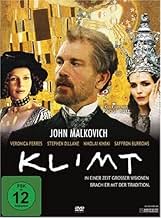Ajouter une intrigue dans votre langueA portrait of Austrian artist Gustav Klimt, whose lavish, sexual paintings came to symbolize the art nouveau style of the late nineteenth and early twentieth century.A portrait of Austrian artist Gustav Klimt, whose lavish, sexual paintings came to symbolize the art nouveau style of the late nineteenth and early twentieth century.A portrait of Austrian artist Gustav Klimt, whose lavish, sexual paintings came to symbolize the art nouveau style of the late nineteenth and early twentieth century.
- Réalisation
- Scénario
- Casting principal
- Récompenses
- 1 victoire et 4 nominations au total
Avis à la une
I didn't like this movie, and I have to say I admire Klimt paintings. I don't think that Klimt was so stiff and also sleepy. There is much more life in one simple photograph from the artist Wiki page, than in this whole movie. All these endless camera rotations around subjects! And too much too loud music... And actually an absence of scenario...
They tried to sell this movie to public - nudes, decadent atmosphere, this misleading label. The ratings show that they failed... I give it 5 for some visual enjoyment I had... and some women hats there were really-really amazing!
Gustav Klimt (1862 - 1918) was a strange artist, a man who believed in a sensualist artificial religion and an artist who favored erotic imagery in his canvases. He was controversial in his time, yet today his paintings using gold leaf and silver leaf and design patterns of expression that defined Art Nouveau sell for many millions of dollars: his style is still imitated and he is still celebrated as the father of erotic art. The film opens and closes with Klimt (John Malkovich) submerged in healing waters in a rather stark hospital, attended by a nurse and his disciple, the equally sensational Egon Schiele (Nicolai Kinski, keeping his hands in the spread-finger style Schiele painted so often!). From this point bits and pieces of Klimt's bizarre life are explored, at times explained through imaginary conversations with his secretary (Stephen Dillane). His marriage, his 'affair' - or is it simply a manifestation of the influence of a muse? - with Lea de Castro (Saffron Burrows), his self indulgence in all things erotic (he is said to have has many affairs with Viennese women yielding a large number of children who bear his genetic puzzle), and his conflict with the Academy of Art, a sense of disgust with the current oeuvre of painting as sterile, and his prodigious output of paintings and drawing of the female nude - all are depicted with tremendous imagination here. The cinematography is as strange as the story it captures, using falling snowflakes in one scene to suggest the falling pieces of Klimt's gold leaf enhancement of his most famous works in others.
The dialogue is at times raw and at other times superficial and the audience is begged to indulge in the fantasy that is being recreated. But the film stands well as an example of an art history period and John Malkovich makes a credible Klimt. This is more a film for art students and art lovers who are eager to explore the beginnings of Art Nouveau than a film for audiences eager for accurate biography.
Grady Harp
John Malkovich is talented but so quirky and full of himself he nearly ruins many of his movies. Surely he sees how affected he can sometimes be? Here he plays the Austrian artist Gustav Klimt in the years before WWI, and though we don't quite know what Klimt was like, we know he didn't play his life being John Malkovich. Biopics always struggle with the character against the actor, of course, since history is what it is, and so you swallow all this and see what the actor and the director can do within these constraints.
The director in this case is the late Raul Ruiz, the Chilean director who just died in Paris with a small cult following and a growing reputation. He concentrates not on Klimt's art, or even Klimt's attitudes as an artist of his time (this is the time of early Picasso, late Cezanne, and the growing influence of Gauguin). Instead it deals with Klimt's personality, which we know the least about, emphasizing his vulgarity, his obsession with nude women around him as much as possible, and his countless children for whom he apparently did as little as possible.
What might have been more interesting is to see a young Klimt being transformed by a 6th century Italian fresco with all its gold leafwork (this is true), or to maybe see him interact with the Vienna Secessionists in their effort, as a group, to break from the academy. What we get instead is a fantasy about the women around him, including a bizarre and willing entrapment of Klimt by a wealthy woman and her double (or twin?) which turns into a kind of erotic sex game with a man watching behind 2-way glass. Then there is a mysterious fellow who seems to only exist in Klimt's head--he's fascinating, yet only half realized.
If Ruiz had taken all this into something purely fantastic, where the trappings of history were shed, it might have been a transporting and special movie, an actual cinematic experience on its own terms. At times it tries, and there are some distortions and some beautiful moments, a bit out of place in the narrative, that stand on their own.
But mostly this lurches and jerks from situation to situation. The art is great, what we see of it, and the sets are nice, though even they are filmed too often with a yellowed dullness that defies the outrageous decorative beauty of the time. (I just happened to see "The Wings of the Dove" set in the same period and the set and costume design blows "Klimt" away). All of this is too bad especially for an art movie about an artist who believed in total aesthetic immersion--where everything, including your toilet paper holder, had to be an artistic component of a life of art.
It's not a disaster, but it's certainly a feminist's nightmare--where Klimt might have defended his painting of women as being honest and where the sex might have been free expression and liberation, the movie pushes all this into pure voyeurism and submissiveness. Women dangle and prance and decorate the movie sets, and your screen, the way Klimt, who was no feminist, might have approved, but which isn't accurate. It isn't about an equality in free loving sex, it's about women from a man's point of view. Period. Some of you will like that, but I did not.
Le saviez-vous
- AnecdotesRyan Phillippe was considered for the role of Klimt.
- GaffesWhen Klimt mashes the cake in the man's face, the icing on the man's face is not covering his right eye. In the next close-up shot, there is a large blob of icing covering the man's right eye. In the next long shot when Klimt starts to wipe the man's face, the icing is no longer covering the man's right eye again.
- Citations
Klimt: Who art thou Asked the guardian of the night From crystal purity I come Was my reply And great my thirst, Persephone Yet heeding thy decree I take to flight and turn, and turn again Forever right I spurn the pallid cypress tree Seek no refreshment at its sylvan spring but hasten on toward the rustling river of Mnemosyne Wherein I drink to sweet satiety And there, dipping my palms between The knots and loopings of its mazy stream I see again, as in a drowning swimmers dream All the strange sights I ever saw And even stranger sights no man has ever seen
- Versions alternativesA 131-minute-long Director's Cut was released theatrically in Austria and is available on DVD in the UK.
- ConnexionsReferenced in Ricardo Aronovich, avec mes yeux de dinosaure du cinéma (2011)
Meilleurs choix
- How long is Klimt?Alimenté par Alexa
Détails
- Date de sortie
- Pays d’origine
- Sites officiels
- Langues
- Aussi connu sous le nom de
- A Viennese Fantasy à la manière de Schnitzler
- Lieux de tournage
- Sociétés de production
- Voir plus de crédits d'entreprise sur IMDbPro
Box-office
- Montant brut aux États-Unis et au Canada
- 97 656 $US
- Week-end de sortie aux États-Unis et au Canada
- 2 332 $US
- 24 juin 2007
- Montant brut mondial
- 584 991 $US
- Durée2 heures 11 minutes
- Couleur
- Mixage
- Rapport de forme
- 1.85 : 1
Contribuer à cette page




